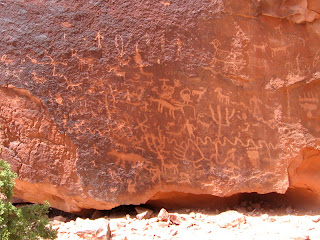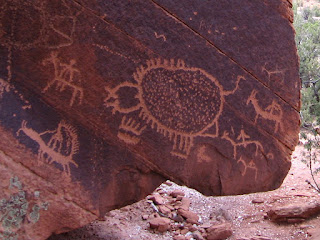Over Memorial Day weekend, Scout and I hiked in the Dominguez Canyon, starting from the Bridgeport end that is accessible from Highway 50, south of town about 20 miles. After crossing the Gunnison River on a beautifully designed steel pedestrian bridge, we passed through the river rafters' campsites and worked our way up into the canyon on a well-used trail. In addition to the petroglyphs I hoped to see, some people we met on the trail told me about an impressive waterfall we should be sure to see that was off the trail about five minutes before the petroglyph area.
The petroglyphs were pecked into rock surfaces immediately adjacent to the trail, so there was no difficulty finding them. I noticed right away that the petroglyphs in these murals seemed much more recent than the ones I have seen around Moab and other places. The contrast between the art and the background was much more pronounced, and the images were more distinctly recognizable as humans, animals and symbolic designs. The biggest clue, though, was that several of the images depicted humans on horseback. Horses were introduced into the New World by Spanish explorers only 500 years ago, so these petroglyphs would have been created by the Native Americans who populated western Colorado in the years since then: the Utes.
The most dramatic of the murals showed several humans on horseback hunting an abstract-looking creature that I interpreted to be a bear based on the paw print associated with it. The lead hunter appears to be wearing an elaborate headdress and riding a larger horse. As is unfortunately the case with most petroglyphs, idiots have added graffiti to the mural in the form of initials and a crude, scratched-in version of a horse. True petroglyphs are pecked into the stone, not scratched.
On our way back down from the petroglyph area, Scout and I kept an eye on the stream that runs through the canyon to see if we could figure out where the waterfall would be. There was a point where the stream appeared to run into a wall of rock, so we left the trail to investigate. We found a spectacular waterfall where the stream took a sharp right turn at the rock wall and the water fell more than 50 feet to the gravel below. The stone surface beneath the stream, leading up to the falls, was well-worn, leaving shallow pools that Scout felt obliged to swim in and cool off.
The following weekend was Nan's and my wedding anniversary, and we celebrated by hiking the Palisade Rim Trail, at the far eastern end of Palisade, east of Grand Junction off Interstate 70 and above the Colorado River. Even with an early morning start, it was a hot and buggy hike. There was a large crew of volunteers working to get the trail into shape for mountain biking, which is the trend in this area: Trails that have been used by hikers and horseback riders for years are discovered by mountain bikers, modified to accommodate their needs, and then overrun by them. I'm not anti-mountain biking, but there are riders out there who could stand to learn some trail etiquette. The main reason I don't ride myself is because I don't think it would be fair to Scout to have him try to keep up with me. So I hike with him instead, and he is happy.
The petroglyphs we found on this hike were not so impressive. The murals were smaller, and there were fewer of them. The petroglyphs appeared to be of the same vintage as the Dominguez Canyon ones and depicted similar scenes, so we guessed that they were also created by the Utes who inhabited the area and perhaps used this remote mesa above the Colorado River as a hunting camp. The primary difference I noticed was that these petroglyphs were mostly of deer and elk, while the Dominguez Canyon ones were mostly of bears and bighorn sheep, leading me to think that the fauna in the two areas were at least somewhat different even though the areas were only 30 miles apart.
On Independence Day, Scout and I returned to Dominguez Canyon, this time with Nan. I wanted to share the petroglyphs and the waterfall with her. It had been very hot since Scout and I had done the hike a few weeks earlier, and the stream in the canyon had dried up. The waterfall was not flowing, and there was only a single pool of water left. It was filled with tadpoles striving to become desert frogs if the pool did not evaporate first.
Nan was having issues with her hips, so the dried-up waterfall was her turnaround point. Scout and I proceeded quickly up the trail from there to snap some photos of the petroglyphs to show Nan what she was missing. When we caught back up with her, she spotted some desert bighorn sheep in the fields on the other side of the canyon. There was a flock of about a dozen, grazing and keeping an eye on us. They were a thrill to see. I found out later that they had been recently reintroduced to the canyon, presumably after being hunted out of existence by the Utes many years before and leaving only their images on the stone walls to show they had once been there.

 Raising Charlie: The Lessons of a Perfect Dog
Raising Charlie: The Lessons of a Perfect Dog











No comments:
Post a Comment